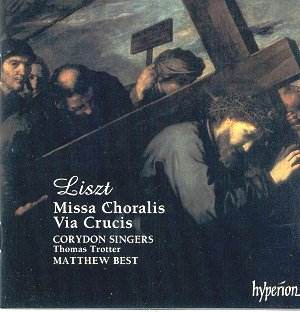FRANZ LISZT
Missa Choralis
Via Crucis
 Elizabeth Atherton
Soprano
Elizabeth Atherton
Soprano
Jane Bovell Soprano
Harriet Webb Mezzo-soprano
Jeanette Agar Contralto
John Bowley Tenor
Peter King Tenor
Leigh Melrose Baritone
Nicholas Warden Bass
CORYDON SINGERS
Thomas Trotter Organ
Matthew Best Conductor
 Hyperion CDA 67199
Hyperion CDA 67199
Crotchet
£11.99
Amazon
UK £11.99
AmazonUS $17.97

Liszt's Missa Choralis was written in 1865 during the period he was
resident in Rome and took holy orders. He spent much of this time following
an almost monastic existence as guest of Cardinal Gustav Hohenlobe, and devoted
himself to studying and composing church music - including the oratorios
St Elizabeth and Christus. All of this was in stark contrast
to his life in the 1830s and 1840s when he was constantly touring all parts
of eastern and western Europe, enjoying a flamboyant, raffish, womanising
lifestyle and revelling in the adulation of his besotted admirers. His apparently
abrupt transition from the profane to the sacred puzzled many at the time
and ever since. We should recall however that, after high public exposure
as a child prodigy, he spent his adolescent years, following the death of
his father in 1826, in much religious reflection and reading. It was
only in his 20s and 30s that he became fired up and embarked on the "outrageous"
compositions and performances for which he is best remembered. We may conclude
that Liszt's period as Kapellmeister at Weimar (1848-58) saw a re-awakening
of his youthful religious preoccupations. Certainly his move to Rome occurred
with a sense of mission: to restore mystical depths to church music and rescue
it from the "operetta" style into which it seemed to have degenerated - hence
his deep study of Palestrina. Set in this context, we can understand the
pivotal importance of the Missa Choralis in Liszt's musical and
psychological development.
Whatever his admiration for Palestrina, and his occasional incorporation
of plainchant themes and use of mediaeval modal tonality, Liszt's music here
is in no way derivative and contains no complex polyphony. Much of it is
either unison or homophonic. It is essentially the simple expression
of profound emotion, yet expressed in terms of wide ranging changes of tonality
- sometimes abrupt and sometimes so skilfully subtle that the listener is
unaware of just how bizarre a journey of modulation his ears are being taken
through. The structure of the movements follows 18th century
convention, in its reflecting the mood and sense of the text, and in the
alternation of soloist ensemble and full chorus. The setting could thus be
said to stand in line of descent from the tradition of Haydn and Mozart -
but, importantly, with the "operatic" frills removed: there are no ornate
melismata and no long instrumental ritornelli. The organ accompaniment, where
used, is complementary and almost never heard on its own. The singing is
thus a capella with organ support. The music is amply served by the
Corydon Singers under Matthew Best. This choir has a well-earned reputation
for 19th and early 20th century choral music and its
talents are ideally suited to this rendering of Liszt. Especially profound
poignancy is achieved in the angst sections: Qui tollis in the
Gloria and Crucifixus in the Credo.
Via Crucis also comes from Liszt's "religious" period, being composed
in 1866. It illuminatingly shows how the mind of the creator of this music
was all part of the same joined-up psyche as that of the composer of his
most extravagant piano and orchestral works. It belongs to that favourite
formula of Liszt: a sequence of short movements based on pictures or statues
- in this case the Stations of the Cross - each one a miniature cameo of
penetrating intensity. A range of texts and themes are used to illustrate
the Station's devotions: Latin hymns (including lines from Vexilla
regis, Stabat mater and Ave crux), Lutheran chorales (his
own harmonisations - not the familiar ones of Bach), quotations from the
Bible, and organ solos. With fifteen movements, lasting very few minutes
each, the whole work's integrated consistency is achieved by much thematic
and textual cross-referencing (as matches the narrative sequence) and by
the repeated use of "The Cross" leitmotif - a rising sequence of just
four notes - two tones and a minor third. These also form the very last notes,
played pianissimo on the organ, of the whole work.
The Corydon Singers and soloists extract the poignant and mournful depths
of the music in full measure. There is no catharsis here, no sneakily
anticipating the resurrection; it is profound pathos and anguish throughout.
It is not for everyday listening - or indeed for recreational concert hall
performance at all. Perhaps this disc should come with a warning label directed
at potential listeners with depressive or suicidal tendencies? Certainly
intense concentrated listening does induce morbid introspection of the darker
regions of the soul. On the other hand, if given less close attention, the
listener risks becoming merely bored. This may go some way to explain why
the work was rejected for publication at the time of its composition and
was never heard in Liszt's lifetime - or indeed until 1926.
This disc will not be everybody's cup of tea. However the quality and
authenticity of the performance makes it especially valuable for those who
wish to enrich their understanding of this key phase in the evolution of
19th century choral music. These are certainly works of a rare
genius, combining (as they do) without inconsistency the ancient traditions
of plainchant with the mould-breaking iconoclasm of mid-19th century
romanticism.
Humphrey Smith


